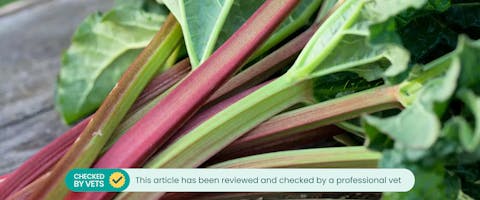Updated 13/07/2023
Whether baking it into a pie, crumble, or cooking it down into a tasty preserve, you may be wondering if it's safe to share your rhubarb with your four-pawed pal. But is rhubarb poisonous to dogs, or can dogs eat rhubarb without any nasty repercussions? Find out as we explore our canine companion’s relationship with this tasty, tart vegetable…
Trending posts
Purr-use some of the top blogs our members have been loving this month- Top male dog names for your new furry friendGot a new furry family member in your pack? Check…

- Top female dog names for your new fluffy palWelcoming a new pooch into your family? Explore…

- 250+ gray cat names your silver feline will loveRecently welcomed a fluffy gray bundle of joy into…

- What are normal pet sitting rates?Discover the average pet sitting rates for animals…

- Unique dog names to stand out from the packDare to be different with our list of the best…

Is rhubarb bad for dogs?
Yes, rhubarb is toxic to dogs. It contains soluble oxalate crystals, which can cause serious illness if eaten. Soluble oxalate is absorbed from the stomach into the bloodstream and goes on to damage organs within the body using the blood as a highway. Plants that contain soluble oxalate are therefore more dangerous than those containing insoluble oxalate (found in other plants), causing whole-body symptoms rather than just at the site of chewing and swallowing as does the insoluble form.
Are rhubarb leaves poisonous to dogs, too? Yes - while all parts of the rhubarb plant contain these nasty, pooch-harming crystals, the leaves contain the highest concentration, making them the most toxic part of the plant. Eating them can cause a sudden drop in calcium - and a whole host of nasty, unpleasant symptoms.
Symptoms
According to the Pet Poison Helpline, the most common symptoms of rhubarb poisoning to watch out for include:
- Drooling
- Loss or lack of appetite
- Vomiting
- Diarrhea
- Lethargy
- Weakness
- Tremors
- Bloody urine
- Changes in thirst and urination
Consuming rhubarb, which contains soluble oxalate crystals, results in the absorption of the crystals from the stomach into the bloodstream where it binds to calcium in the blood to form insoluble calcium oxalate. These newly formed insoluble crystals travel around the body within the blood, causing irritation, swelling, and damage.
The first symptoms are usually related to damage at the site of toxin absorption and calcium oxalate formation, the gastrointestinal system. As the toxin moves around the body and the levels of toxin increase in the body, the symptoms worsen and progress. In more severe cases, with high volumes of ingestion, the crystals can go on to block the vessels of the kidneys, for example, leading to kidney failure. We get other symptoms because the body's calcium is “used up” by binding with the toxic oxalate crystals in rhubarb, it's no longer available in the body for normal function. Weakness and seizures are the result.
Diagnosis
If you suspect your pooch may have eaten some rhubarb (in particular, the rhubarb leaves), it’s key that you contact your vet as soon as possible for advice - even if they aren't yet displaying any symptoms of toxicity. Keep an eye on your dog’s behavior, take note of how much rhubarb you believe your pup has ingested, and if possible, keep a piece of the plant handy. This will all help your vet to decide on the best course of treatment for your pooch.
Treatment
As with all cases of toxicity in pets, treatment will depend on a number of factors (such as the amount ingested and the severity of symptoms your pooch is experiencing).
A visit to the vet is likely to be necessary, especially in cases where the rhubarb leaves have been ingested. Treatment may include IV fluid treatment, medication to eliminate the rhubarb, pain relief, plus a number of tests to assess your dog and confirm the diagnosis.
Remember, only your vet will be able to advise on the best course of treatment, which is why it’s important to seek their advice as soon as possible in cases where you believe your dog has eaten something toxic.
Recovery from rhubarb poisoning is usually good, provided only a very small amount of the plant has been ingested. However, large amounts can cause acute renal failure (kidney failure or damage) and even life-threatening loss of body cell function leading to seizures and possibly death. Be mindful and keep rhubarb well out of paw’s reach, both in your home and outdoors.
Meet our veterinary expert, Lily
This article has been checked by veterinarian Lily Richards BSc (Hons) BVSc MRCVS. Lily qualified from Liverpool University in 2011 and spent 5 years as a veterinarian working in mixed animal practice. As Lily’s passion for exotics and exploring more complicated small animal medical cases developed, she stepped into small animal-only practice. By 2018 Lily was leading a busy branch of a large hospital practice with a fantastic team, enjoying working on both surgical and medical cases. Since falling poorly in 2021 Lily has found a new passion in medical writing. Sharing medical knowledge and writing for the public is a particular passion.
Unfortunately, rhubarb isn’t the only plant that can cause harm to our canine pals. In fact, there are many more poisonous plants that dogs should avoid - here are a just few to get you started:

